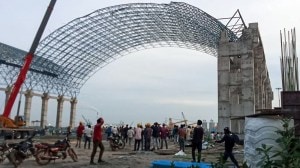No surprise this: Met got monsoon forecast wrong
Finance Minister Jaswant Singh has ended the debate over the rains. Yesterday, he stated — quoting the ‘‘latest data from the...

Finance Minister Jaswant Singh has ended the debate over the rains. Yesterday, he stated — quoting the ‘‘latest data from the Met department’’ — that, despite its late arrival, monsoon rainfall so far has been normal to excess in all the 36 meteorological sub-divisions of the country.
That means the India Meteorological Department (IMD), which was way off the mark last year, got its predictions wrong this April too — while the foreign agencies got theirs right (see box). The IMD wasn’t alone: the Bangalore-based Centre for Mathematical Modelling and Computer Simulation (C-MMACS) also got it wrong.
Though only part of the monsoons is over, it’s enough to judge both Indian agencies by. The IMD’s initial forecast, on April 16, said the monsoon would be below normal; that forecast was valid for the period till July 9, when it revised its forecast. And that period was what Jaswant Singh referred to today.
The first forecast said the monsoon would be below normal at 96 per cent of the average normal index of 88 cm; the IMD then played safe by adding that it would make the final forecast in mid-July. That would be, it said, after watching whether the El Nino (warm) phenomenon was declining and/or La Nina (cooling) was emerging.
Following a month of good showers, the IMD came out with its revised forecast on July 9: the monsoon would be normal.
The IMD doesn’t usually have a revised forecast; this year’s decision came after its prediction last year failed by 19 per cent. It also abandoned the Gwariker (statistical) model of forecasting it had used for 14 years, replacing it with multiple statistical models for forecasts to be made in two periods. Hence last week’s revision.
‘‘We are trying our best’’, says Director-General R R Kelkar. ‘‘We can predict well if we have a dynamical forecast model in place; for that we need real-time weather data from the Arabian Sea, Bay of Bengal, Indian Ocean and from the Himalayas. We need to place buoys in surrounding seas and stations in the Himalayas to give real-time weather data.’’
The C-MMACS was more specific: it predicted that the June rainfall would be below normal in western and northern India and in most parts of eastern India, which hasn’t worked out that way. Similarly, its forecast of a significantly below-normal rainfall in July over southern India doesn’t seem to be holding good.
The Western agencies got it right, however. The US-based International Research Center for Climate Prediction (IRI) was bold enough to say in April itself that India would have a ‘wet monsoon’ (read: excess rainfall) due to the decline of El Nino and emergence of La Nina in the Pacific.
It wasn’t in the volume of rainfall alone that the IMD got it wrong; the timing, too, was erroneous. The monsoons, it said, would arrive in Kerala around June 5-10, whereas the US-based Centre for Ocean-Land-Atomosphere Studies (COLA) and Florida State University (FSA) predicted that it would touch the Kerala coast by June 8, the date it actually did so.
Kelkar says: ‘‘A natural system like the monsoon cannot have a fixed date as such. Data for 120 years shows that (only) on rare occasions has the monsoon touched the Kerala coast on June 1. It has hit the coast either within five days prior to June 1 or between June 1 and 8.’’



- 01
- 02
- 03
- 04
- 05




























